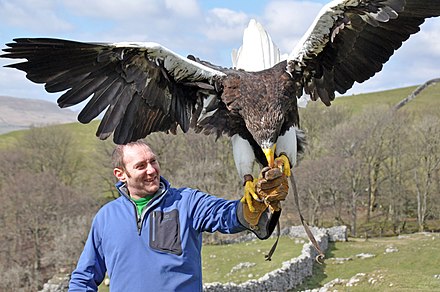Steller’s Sea Eagles (Haliaeetus pelagicus) are large diurnal birds of prey known for their distinctive plumage. While the majority of their body is dark brown to black, they have contrasting white on the lesser and median upper-wing coverts, under-wing coverts, thighs, under-tail coverts, and tail. However, a very rare dark morph, once considered a separate subspecies (H. p. niger), lacks white in its plumage, except for the tail.
The Rare Dark Morph of Steller’s Sea Eagles
The dark morph of Steller’s Sea Eagles, once considered a separate subspecies (H. p. niger), is a very rare occurrence. These birds lack the distinctive white markings that are typically seen on the majority of Steller’s Sea Eagles. Instead, their plumage is predominantly dark brown to black, with the exception of the tail, which still retains some white.
This dark morph is believed to be the result of a genetic variation or mutation that affects the bird’s pigmentation. While the exact cause is not fully understood, it is thought that this coloration may provide some advantages in certain environments or social situations.
Habitat and Distribution of Steller’s Sea Eagles
 Image source: stellers sea eagle
Image source: stellers sea eagle
Steller’s Sea Eagles are native to eastern Russia, specifically the Sea of Okhotsk and the Kamchatka Peninsula. They are also frequent winter migrants to the Japanese Islands of Kuril and Hokkaido. These eagles prefer sea coasts with estuaries and river mouths, where they can easily access their primary prey, fish.
The global population of Steller’s Sea Eagles is estimated to be between 4,600 and 5,100, including 1,830-1,900 breeding pairs. They are considered “Vulnerable” by the International Union for Conservation of Nature (IUCN) due to moderate population decline caused primarily by habitat conversion in their breeding grounds and mortality from lead poisoning during overwintering in inland Japan.
Feeding Habits and Prey of Steller’s Sea Eagles
Steller’s Sea Eagles are primarily fish-eaters, with a diet that consists mainly of salmonids, which they take alive or dead. They are also opportunistic and versatile, feeding on a variety of birds and mammals when their primary prey species are scarce.
These eagles are important predators in their native ecosystems, playing a crucial role in maintaining the balance of the food chain. However, they can sometimes cause harm to the commercial trapping industry during harsh winters when their primary prey is scarce.
Conservation Efforts for Steller’s Sea Eagles
Steller’s Sea Eagles are legally protected in Russia, Japan, China, and South Korea, with key habitat areas established as nature reserves throughout Russia and Japan. These conservation efforts aim to protect the species and its habitat from threats such as habitat conversion, lead poisoning, and other human-related impacts.
Despite these efforts, the Steller’s Sea Eagle population is still considered vulnerable, with a moderate decline in numbers over the past few decades. Ongoing monitoring and research are essential to understanding the species’ ecology and implementing effective conservation strategies to ensure their long-term survival.
Conclusion
In summary, while the majority of Steller’s Sea Eagles have a distinctive pied plumage, a very rare dark morph, once considered a separate subspecies, lacks the white markings and is predominantly dark brown to black, except for the tail. This unique coloration is believed to be the result of a genetic variation or mutation, and its significance in the species’ ecology and social dynamics is not fully understood.
Steller’s Sea Eagles are native to eastern Russia and are frequent winter migrants to the Japanese Islands. They are important predators in their native ecosystems, but their population is considered vulnerable due to various threats, including habitat conversion and lead poisoning. Ongoing conservation efforts are crucial to protecting this majestic species and ensuring its long-term survival.
References:
– https://animals.sandiegozoo.org/animals/stellers-sea-eagle
– https://animaldiversity.org/accounts/Haliaeetus_pelagicus/
– https://owlcation.com/stem/Birds-of-Prey-Stellers-Sea-Eagle
– http://www.raptortag.com/stellers-sea-eagle-ssp.html
– https://animalia.bio/stellers-sea-eagle

